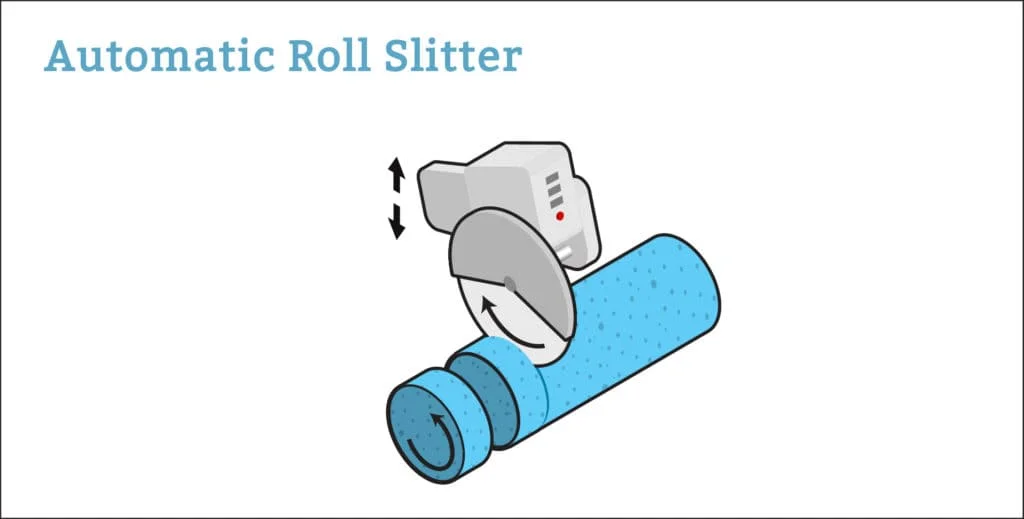Ever bought foam weatherstripping or double-sided tape in individual lengths? Somehow it just doesn’t work. You’d have to peel a backing strip off the pressure sensitive adhesive, there would be joins where you didn’t want them, and you’d have all sorts of wasteful offcuts. That’s why it’s sold in rolls.
Rolls are a wonderful way of packing, transporting and using foam. Like bananas, they make their own outer skin, which makes them easy to move and reduces waste. And while hardware store rolls come in standard widths, here at Merryweather it’s possible to get any width you want.
Like many manufacturing processes, roll slitting seems straightforward until you learn what it takes to produce consistent, high quality results. Here’s your introduction to “The Art of Roll Slitting.”
Why Slit?
Efficient manufacturing, whether of paper, cloth or foam, demands high volumes. To get the throughput, production lines are set up to make material in the widest possible widths. That’s why rolls straight from the mill, loom or foam producer are usually at least 72″ wide, sometimes much more.
Those rolls are convenient for shipping, distribution and storage, but for the end users, not so much. It depends on the application, but many want rolls that are somewhere between 1″ and 6″ wide. Getting to that width means slicing up the roll.
Slitting Processes
There are two ways of slitting wide rolls of material, rewind slitting and log slitting. Selecting the most appropriate depends on factors like the number of rolls needed, the type of material, and the edge quality sought.
Rewind Slitting
In the rewind process the roll is unwound and pulled through a series of blades before being, yes, rewound. Rewind slitting machines can take up a lot of room and have the problem that material is recoiled in the opposite direction to how it came off the roll. For some materials, like those with a pressure sensitive adhesive (PSA) on one side, that means another operation to re-rewind the material back into the original orientation.
Producing thin rolls with rewind slitting can be a challenge as the new roll may become unstable. At best it would have uneven edges, but worst case, it might just be scrap. The other issue is that the whole roll is slit at once, so it’s not really a slit-to-order kind of process. (Yes, it is possible to rewind-slit a roll into just two parts, but why? It would make more sense to use a log slitter.)
Log Slitting
Log slitting really is like cutting a tree trunk into logs. It’s done on machine that’s part lathe and part circular saw. One end of the roll is mounted in a chuck and supported horizontally on long shaft threaded down the center. Moving along the bed of the machine, parallel to the roll, is what looks like a circular saw, although in this process it’s actually a knife.
After loading, both the roll and the knife blade start to turn. Beginning at the end furthest from the chuck, the knife blade is pushed into the material roll, where it parts off a thinner roll of material. To cut the next roll the knife is withdrawn, moved along by a distance equal to the thickness needed, and pushed in again.
The advantages of roll slitting are that it’s fast, there’s next to no set up, and it provides a slit-to-order capability. If asked, it’s possible to cut each roll to a different thickness.
Slitting Capabilities
The log slitter at Merryweather can handle rolls up to 20″ diameter, and the ballscrew-driven knife has a positional accuracy of +/- 0.003″ (0.076mm). That makes it capable of producing very thin, large diameter rolls, sometimes referred to as “pancake” rolls. The minimum core diameter, (the tube at the center of every roll,) is just 1″ and the widest roll that can be slit is 90″.
Edge Quality
It’s difficult to slit rolls so they have a good, clean appearance from the side or end. Knife quality and condition are critical, and so too is the speed of cut. The tightness of the roll also has a bearing on edge quality.
When the blade is dull it tends to compress the material and produce an uneven edge. (The same happens if the roll is loosely wound.) To avoid this, Merryweather use automatic knife sharpening on their slitter. Conversely , when the blade is too sharp it can produce so-called, “angle hair” whiskers of material at the edges.
The speed at which the knife penetrates the material is important too. Move in too fast and the material compresses, move too slowly, and heat build sup in the knife, potentially damaging low melting point materials like foam. The Merryweather roll slitter knife is hydraulically driven for a smooth, well-controlled cut. Depending on the material being cut, water or a lubricating material might be sprayed on to the knife to help it work more easily.
Attention to Detail
For material that’s sold in roll for, like foam weatherstripping, or foam coated on one or both sides with a PSA, roll slitting is an essential process. Both the rewind and log slitting process can deliver good results, when done with care on quality machinery. There is after all, an art to roll slitting!
Have questions? We’re here to help! Please get in touch with us regarding your next project and we will be happy to answer your questions!


